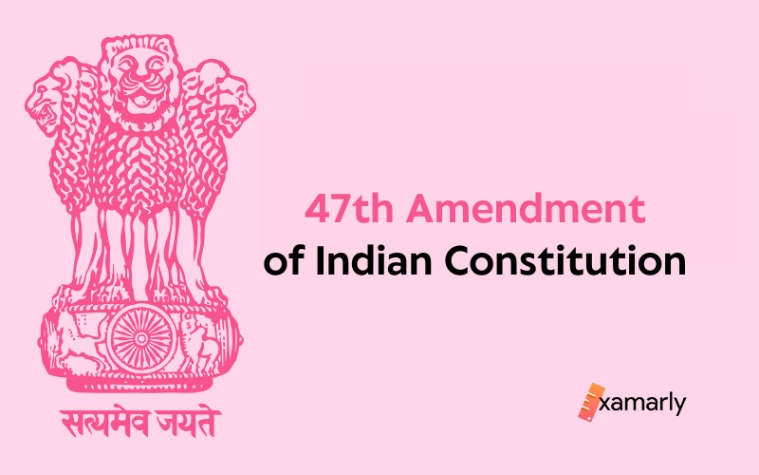Formally know as the Constitution (Forty-seventh Amendment) Act, 1984, this amendment included 14 land reform acts in the Ninth Schedule.
The states of Assam, Bihar, Haryana, Tamil Nadu, Uttar Pradesh, and West Bengal, as well as the union territories of Goa, Daman, and Diu, passed these laws.
Read this article to get in-depth knowledge about the 47th amendment of Indian constitution.
47th Amendment of Indian Constitution
This changed the Constitution’s Ninth Schedule. This was done in order to ensure that the laws won’t be declared invalid on the grounds that they conflict with any of the fundamental rights provisioned in Part III of the Indian Constitution.
This amendment act was enacted in the thirty-fifth year of India becoming a Republic.
Related Articles:
Proposal and Enactment
The 47th amendment of Indian Constitution was proposed in the Lok Sabha on August 19, 1983. It was first introduced as the Constitution (Forty-eighth Amendment) Bill, 1983. It was introduced by Harinatha Misra, who was the Minister of State for Rural Development.
On August 22 and 23, the Lok Sabha debated the Bill. The brief title of the legislation was changed to the Constitution (Forty-seventh Amendment) Act, 1984 after it was formally passed on August 23, 1984.
On August 25, 1984, the Rajya Sabha took the Bill under consideration and approved it as enacted by the Lok Sabha.
Also Read about: Powers and Functions of Lok Sabha and Rajya Sabha.
Key Features of the 47th Amendment
| Who introduced it? | Harinatha Misra, who served as the Ministry of Rural Development’s State Minister at the time presented it. |
| When was it Introduced? | In the Lok Sabha on 19 August 1983. |
| The official name of theAmendment: | The Constitution (Forty-seventh Amendment) Act, 1984. |
| Which articles were amended? | Schedule 9. |
Important for UPSC Preparation: Schedules of the Indian Constitution.
Statement of Objects and Reasons
- The Constitution’s Article 31B protects the laws listed in the Ninth Schedule against allegations that they violate any fundamental rights. The immunity does not apply to any modifications made to these Acts after they were added to the Ninth Schedule.
- In the past, when court cases showed that progressive laws made in the public interest were in danger, the Ninth Schedule could be used.
- The Ninth Schedule already includes a number of State laws concerning land reform and holding limits for agricultural land.
- The Sixth Five Year Plan (1980–1985) promises that “necessary action would be taken to bring before Parliament land reform Acts not yet included in the Ninth Schedule to the Constitution for immediate inclusion in the said Schedule” and that “the same would be done in the case of future Acts without delay”. This was done to protect these laws from challenge in courts.
- Some of their Acts have been proposed for inclusion by the state governments of Assam, Bihar, Haryana, Tamil Nadu, Uttar Pradesh, and West Bengal, as well as the administration of the union territory of Goa, Daman, and Diu.
- These laws are linked to the land changes in the ninth schedule. Some of the proposed Acts, which are currently on the Ninth Schedule, are changes to existing Acts.
- The examination has been done on the many Acts that have been put out for inclusion. Additionally, it is suggested that the Acts that have either been challenged or are likely to be contested be listed in the Ninth Schedule, so as to prevent litigation from impairing the implementation of these Acts.
The Bill aims to accomplish the goal mentioned above.
If you’re interested to know about the States of India, you might like to read our blogs on:
Important Provision of the 47th Amendment
Amendment of the Ninth Schedule
The following Acts(entries No. 189 to 202) have been included in the Ninth Schedule to the Constitution:-
- 189. Assam (Temporarily Settled Areas) Tenancy Act of 1971 (Assam Act XXIII of 1971).
- 190. Assam (Temporarily Settled Areas) Tenancy (Amendment) Act of 1974 (Assam Act XVIII of 1974).
- 191. Bihar Land Reforms (Fixation of Ceiling Area and Acquisition of Surplus Land) (Amendment) (Amending) Act of 1974 (Bihar Act 13 of 1975).
- 192. Bihar Land Reforms (Fixation of Ceiling Area and Acquisition of Surplus Land) (Amendment) Act of 1976 (Bihar Act 22 of 1976).
- 193. Bihar Land Reforms (Fixation of Ceiling Area and Acquisition of Surplus Land) (Amendment) Act of 1978 (Bihar Act VII of 1978).
- 194. Land Acquisition (Bihar Amendment) Act of 1979 (Bihar Act 2 of 1980).
- 195. Haryana Ceiling on Land Holdings (Amendment) Act of 1977 (Haryana Act 14 of 1977).
- 196. Tamil Nadu Land Reforms (Fixation of Ceiling on Land) Amendment Act of 1978 (Tamil Nadu Act 25 of 1978).
- 197. Tamil Nadu Land Reforms (Fixation of Act Ceiling on Land) Amendment Act of 1979 (Tamil Nadu 11 of 1979).
- 198. Uttar Pradesh Zamindari Abolition Laws (Amendment) Act of 1978 (Uttar Pradesh Act 15 of 1978).
- 199. West Bengal Restoration of Alienated Land (Amendment) Act of 1978 (West Bengal Act XXIV of 1978).
- 200. West Bengal Restoration of Alienated Land (Amendment) Act of 1980 (West Bengal Act LVI of 1980).
- 201. Goa, Daman and Diu Agricultural Tenancy Act of 1964 (Goa, Daman and Diu Act 7 of 1964).
- 202. Goa, Daman and Diu Agricultural Tenancy (Fifth Amendment) Act of 1976 (Goa, Daman, and Diu Act 17 of 1976).
You might also like to read about: Difference Between Act and Law.
Summary
The 47th Amendment went into effect on 26 August 1984. This amendment modifies Schedule 9 of the Indian Constitution. This adds the Land Reform Act and its amendments to the ninth schedule.
Read Also:
- Previous Amendment: 46th Amendment of Indian Constitution.
- Next Amendment: 48th Amendment of Indian Constitution.
FAQs on the 47th Amendment of Indian Constitution
What are land reform acts?
Land reform acts are laws that aim to redistribute land from large landowners to landless farmers or small landholders. These laws seek to promote social justice by providing equal access to land, reducing inequality, and improving the living standards of poor farmers.
Which land reform acts are included in the Ninth Schedule?
Several land reform acts have been added to the Ninth Schedule, including the Bihar Land Reforms Act, the Kerala Land Reforms Act, and the Maharashtra Agricultural Lands (Ceiling on Holdings) Act.
Why were these land reform acts added to the Ninth Schedule?
These land reform acts were added to the Ninth Schedule to protect them from legal challenges. Large landowners who were affected by these laws challenged their constitutionality in courts, and adding them to the Ninth Schedule made them immune to judicial review.
What is the controversy surrounding the inclusion of land reform acts in the Ninth Schedule?
Some people argue that adding land reform acts to the Ninth Schedule violates the basic structure of the Constitution, which cannot be amended. The Supreme Court has upheld the validity of the Ninth Schedule but has also ruled that laws added to it cannot violate the basic structure of the Constitution.
What is the basic structure of the Constitution?
The basic structure of the Constitution refers to its fundamental features, which cannot be amended or altered. These include the principles of democracy, secularism, and federalism, as well as the separation of powers between the executive, legislature, and judiciary.






